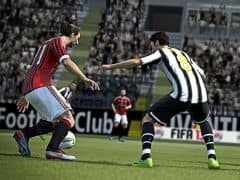Video Gamer is reader-supported. When you buy through links on our site, we may earn an affiliate commission. Prices subject to change. Learn more
Every year, the same words get attributed to the latest iteration of EA’s pig-skin outing: ‘revolution’, ‘innovation’, ‘evolve’, ‘overhaul’. There’s a simple reason for this: it’s because the development team refuse to rest on their laurels. Every year we sit down and play FIFA, we ask ourselves: “Where can they take it from here?” Luckily, we’ve had the chance to find out.
FIFA 12 was all about fundamentally changing the defensive mechanics. Before this, your options were limited to pressing A/X to press the ball, B/O to have a second man double up with you, or try a slide tackle. It was all a bit too passive. Then EA introduced tactical defending, which brought a whole new level of strategy to the defensive side of the game. There was a lot for players to sink their teeth into. No longer could you just sit idly by as your team defended for you; it became a game of patience, waiting for your opponent to make that critical mistake.
This new defending system came at a cost, though, with FIFA 12 feeling like a much slower affair than its predecessors. Players now had far more defensive options at their disposal than they had when going forward. Attacks quickly fell flat in the final third of the pitch because forwards didn’t have the same creativity as defenders. AI attackers often ran into offside positions, leaving you no option but to shoot or take on five or six men. Now, FIFA 13 looks to complete the circle by revolutionising attack.
Playing a few matches of FIFA 13, it quickly becomes clear how prominent these aggressive improvements are to the flow of the game. The first noticeable addition is the adaptation of the excellent close-ball control system from FIFA Street, now dubbed Complete Dribbling. Dribbling is much more effective this year: You aren’t forced to use flashy dribble moves to beat players, but can use close control a la Messi to find space. When this is combined with the new Pro Player Intelligence, attacking plays feel much smoother. Players make smart runs, rather than merely wandering into an offside position. You will see Van Persie bend his run across the defence, giving you the opportunity to slide the perfect pass behind Chelsea’s back four. This helps maintain attacking momentum, and in general transitioning from defence to offence is much quicker than in FIFA 12.
Players are in space far more often in this year’s game. Instead of standing around marked, they’ll actively seek space on the pitch. Lead producer David Rutter claims players will think two or three passes ahead of the play, meaning men who aren’t directly involved in the attack will make runs for when the ball shifts to their side of the field. It’s a small change, but it makes a huge difference.
This year’s dynamic first touch control system adds a new level of realism to FIFA. League Two players are no longer able to bring a 50-foot high clearance down on a sixpence. Balls can bounce off a defender’s shins into the path of an attacking player, a promising attack can break down thanks to a winger’s unreliable control. When you choose to close down a team that passes the ball across the defence, you feel like you have a genuine chance of intercepting the ball – and in turn, this forces defenders to clear the ball much quicker than they would like. In FIFA 12, possession football and keeping the ball in the defence was a preferred option, but it now becomes increasingly risky as the attackers press the ball.
Of course, there have been some new additions to defending to help balance the attacking overhaul. For one thing, EA has majorly improved the “push-pull” mechanic. Last year Manchester United’s Ashley Young had no problem out-muscling the likes of John Terry and Jamie Carragher to keep possession. Now, stronger players will more often barge smaller rivals off the ball without lunging into a tackle, or at the very least disrupt their opponent’s centre of gravity, forcing a mistake. This leads to intricate battles of speed v strength: outpaced defenders have the option to pull the striker back, but only at the risk of a foul and possibly a sending off. There’s also the ability to step into the path of an oncoming attacker, blocking their attempt to run after a ball they’ve knocked past you – a much better solution to the weak lunging tackles of old.
FIFA 13 feels very much like FIFA 12’s second-half. EA has now completely changed both attack and defence to the point where every moment feels like a chess match. The defender shepherding the ball-carrier is waiting for a heavy touch; the second defender following the runner is trying to force him into an offside position while making sure he doesn’t lose track of his man. The striker closing down the defender as he attempts to bring down a high ball is ready to pounce on a heavy touch – especially if it’s Titus Bramble. And the striker bringing the ball forward is waiting for the defender’s feeble attempt at a tackle before skipping past to take on the ‘keeper.
In short, every moment in FIFA 13 feels important – and the game feels far more rounded as a result.
FIFA 13 will be released on September 29 on all leading formats
